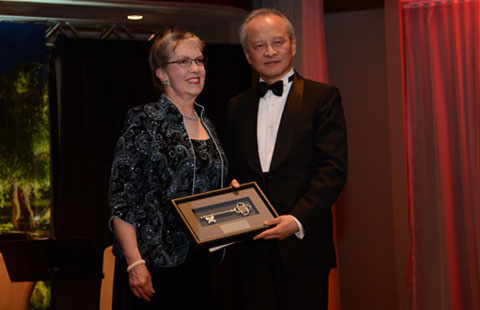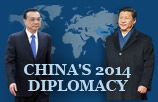Small price, big benefit
Updated: 2014-10-21 18:16
(China Daily)
|
||||||||
The latest government statistics were not ambiguous about the economy’s performance in the third quarter. The nation’s GDP growth slowed to its lowest rate in six years.
So far in 2014, China has seen GDP grow, year-on-year, 7.4 percent in the first quarter, 7.5 percent in the second and 7.3 percent in the third. It will probably miss, albeit by a small margin, its annual growth target of 7.5 percent.
A slowdown in growth, of course, would not be good news for those seeking short-term returns, judging from all the signs in the market.
Nor is the slowdown surprising, as seen from the long-term perspective. It is part of a process of trade-offs, with their inevitable pains, that the economy must go through to shed outdated, less-productive capacity and make room for new and more creative business initiatives.
It is a process that Premier Li Keqiang likes to compare to a warrior cutting off his own wounded arm so he can continue fighting.
This sort of transition, the subject of economics talk for a long time, begins to make genuine progress only when the necessary price is paid — and that is happening now.
Economists can predict, from all the factors contributing to the third quarter’s slowdown, a number of changes that, however uncomfortable they may be now, will improve, rather than drag down, growth in the future.
First, all government offices, especially those at local levels, are more prudent in their fiscal planning and more responsible for the consequences of their financial decisions, as amendments to laws and policies require. Since local governments have already incurred a formidable amount of debt from previous investment sprees, it is about time they were told to go slow.
Second, trimming the local governments’ investment activities has helped the financial system focus resources on the more worthy projects.
Third, the growth in services (7.9 percent in the third quarter) is strong compared with that of industry (7.4 percent), and it may become even more robust as the transition continues thanks to the cooling of the government’s investment enthusiasm.
Fourth — and of particular importance — there has been a noticeable pause in new land-development projects and a reduction in the once widespread demand for new, and ever more expensive, housing units.
All of these factors are likely to protect the economy’s health and growth potential in the long run. China has earned that benefit by paying the very small price of 0.2 percentage points in its quarterly GDP results.

 Music at her fingers
Music at her fingers
 Across America Over the Week (Jan 16 - Jan 22)
Across America Over the Week (Jan 16 - Jan 22)
 Spend Chinese New Year in style
Spend Chinese New Year in style
 Ili river valley becomes a popular destination for swans
Ili river valley becomes a popular destination for swans
 Philip Ma: from scientist to businessman
Philip Ma: from scientist to businessman
 Birmingham's Spotlight on China dinner
Birmingham's Spotlight on China dinner
 How to distinguish doucai, wucai, Famille-rose and enamel porcelain
How to distinguish doucai, wucai, Famille-rose and enamel porcelain
 Xinjiang lake in bumper fishing season
Xinjiang lake in bumper fishing season
Most Viewed
Editor's Picks

|

|

|

|

|

|
Today's Top News
Houston's SW Chinatown
China to focus on reforms, opening of capital market
Slowdown brings new risks to banks
Trade group calls for BIT
Market status for China is 'political' issue
Birmingham's Spotlight on China dinner
Bank takes renminbi-clearing seriously
Traditional Garb
US Weekly

|

|







